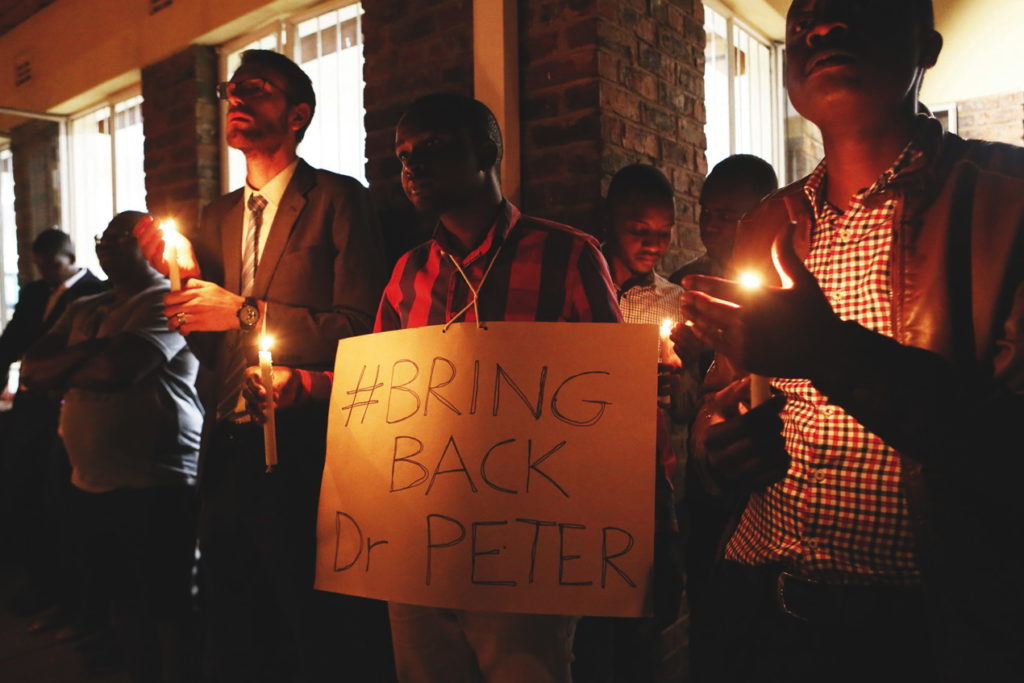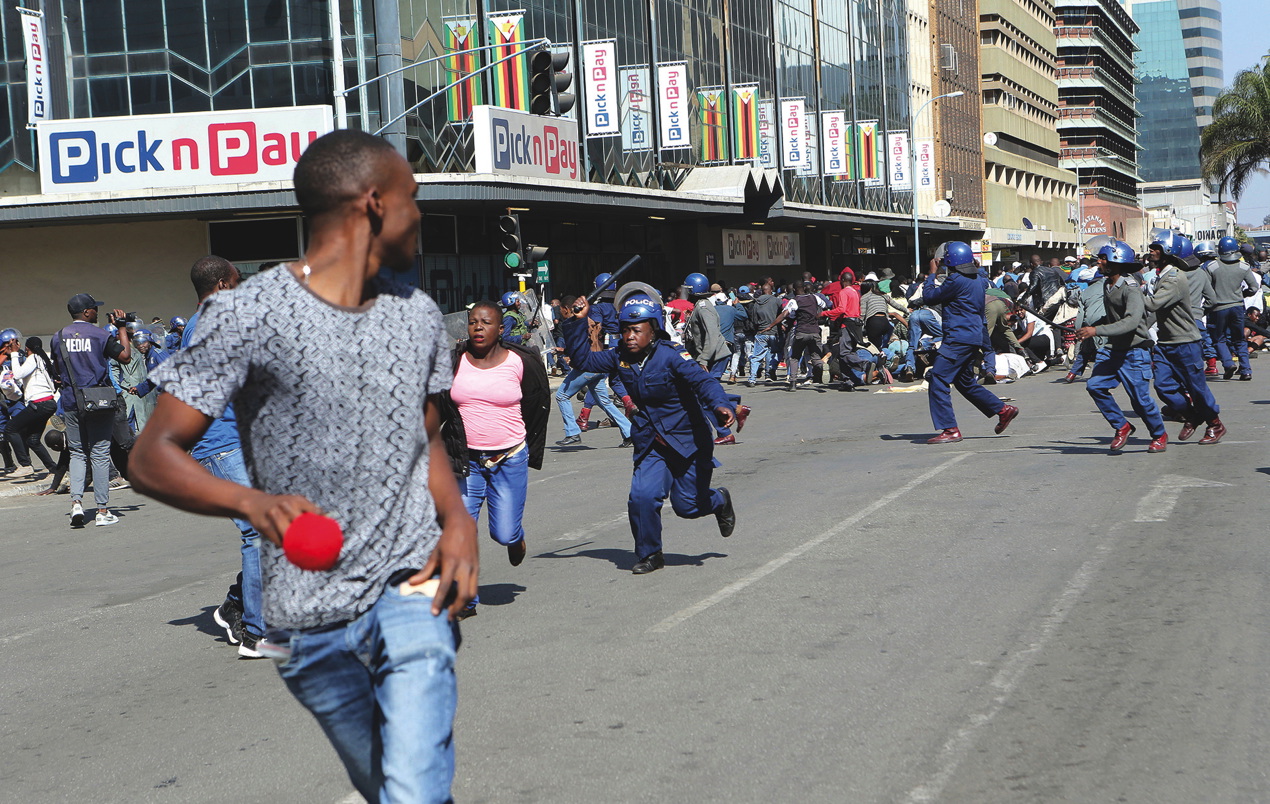On the same charge sheet
Some believed the end of Robert Mugabe’s decades-long authoritarian rule in Zimbabwe would bring opportunities for freedom and growth. But the reality of a brutal crackdown is depressingly familiar
Economic crisis unfolds, inflation rises daily and electricity cuts leave people in the dark, sometimes for more than 72 hours. Fuel queues span kilometres, medical equipment and drugs are scarce, and household items in the shops are almost too expensive to afford. The government’s solution to Zimbabwe’s problems? Countless abductions, violence and military repression.
“Even in my capacity as a lawyer, I was arrested and have been charged along with the teachers.”
Yet the eyes of the world have been averted from Zimbabwe’s plight since the death of its former president, Robert Mugabe, earlier this month, as heads of state and neighbouring countries focused on mourning the legacy of the man who was seen by some as an icon of liberation and martyr of the African revolution.
Following Mugabe’s downfall in a military coup in 2017, Emmerson Mnangagwa was elected president, promising a “new dispensation” to solve economic problems and bring prosperity to every corner of the country. But that has not materialised, and a series of strikes, protests and demonstrations have taken place since Mnangagwa’s inauguration.
“Zimbabwe is in a worse place, on virtually any indicator, today than it was in the previous few years,” says human rights lawyer and political activist Doug Coltart. “There is a lot of tension on the ground, a lot of anger and frustration, but the moment anyone tries to express any form of discontent, there has been an absolutely brutal crackdown by the security forces.”
Only a week ago the Parirenyatwa Hospital, the largest hospital in Harare, filled with doctors on strike, peacefully demonstrating for the return of their colleague and head of the Zimbabwe Hospital Doctors Association (ZHDA), Dr Peter Magombeyi, who went missing over the weekend.
Dr Magombeyi recently led strikes to pressurise Mnangagwa’s government to raise wages for medical staff. The ZHDA said Dr Magombeyi had not been heard from since he sent a WhatsApp message saying he had been “kidnapped by three men”.
The doctors chanted “No Peter, no work” and “Free Dr Magombeyi unharmed now”, despite police warning them not to make kidnap allegations so as not to tarnish the country’s image. State abductions are nothing new for Zimbabweans and more often than not result in the victim’s death. More than 50 abductions have been reported since January and his supporters feared the worst.
On 18 September doctors and nurses planning to march from the hospital to Zimbabwe’s parliament said they had received death threats from security forces, although the police would not comment. A day later, the county’s high court ordered police not to interfere with the march.
But on 19 September Dr Magombeyi managed to contact colleagues, saying he had been dumped somewhere but was unaware of his location. Using GPS they managed to locate him in Nyabira, 40km west of the capital. But the police got to him before a rescue team of lawyers and doctors could.
He was taken to Harare Central Prison where he was detained and denied
access to his lawyers and medical assistance. The doctor was finally released on 20 September and reunited with his family.

Interviewed by Voice of America, Dr Magombeyi sounded confused, saying he had no physical obvious injuries but felt some pain. He also said he remembered being in a basement of some sort and being electrocuted, but little else.
Other campaigners and demonstrators have suffered violence too. The Zimbabwean human rights NGO Forum recorded at least 844 human rights violations after the 14 January national stay-away that followed the government’s announcement of a large increase in fuel prices. That included 12 killings, 78 injuries from gunshots, 242 cases of assault, torture, inhumane or degrading treatment, 46 cases of vandalism, looting and property destruction, and 466 arbitrary arrests and detentions. The government also blocked social media and access to information.
Knox Chitiyo, associate fellow in the Africa programme at thinktank Chatham House, says: “What has happened this year and last year is not new to Zimbabwe. We do have a tradition of popular protest but I think people are beginning to see that protesting hasn’t really followed through.
“People are very wary in terms of the protest route. They are not convinced that it’s going to bear fruit.”
A month ago, people took to the streets again as the country’s economic woes heightened. They waited to hear the result of an appeal at the High Court that would allow them to peacefully demonstrate. The court challenge sought to overturn a police ban on demonstrations instated the previous evening, using the notoriously repressive Public Order and Security Act. The police claimed they had evidence that the protest, planned by the opposition Movement for Democratic Change (MDC) party, would turn violent. The appeal was rejected.
Eye-witness accounts say that blue-helmeted riot police then charged the protesters who were sitting down on the streets adjacent to Africa Unity Square awaiting the response. Women, the elderly and those who couldn’t run away fast enough were targeted first. Tear gas was used to disperse the public and people were brutally assaulted with batons and whips, while others were rounded up and loaded into armoured vehicles. The police had checkpoints set up around town to search vehicles for MDC members. The MDC headquarters were blocked off.
The week’s crackdown came after mounting tensions. At least six prominent opposition activists were abducted in the build-up, with three of them being badly beaten up and dumped on the streets of Harare. Police prevented several protests planned over the following week.
A week later, on 23 August, the teachers union, which is exempt from POSA, tried presenting a petition to the Ministry of Finance against the depreciation of their salaries due to soaring inflation. A brutal crackdown was seen yet again. As the lawyer assisting those teachers, Coltart was assaulted and arrested.
“Even in my capacity as a lawyer, I was arrested and have now been charged along with the teachers,” he tells Big Issue North. “It demonstrates the extremity the government is willing to go to clamp down on any form of dissent.
“The repression and violence we have seen in the past year is more brutal than we ever saw in the latter years of Mugabe’s rule.”
Civil servants in Zimbabwe are paid badly while public services lack maintenance and are slowly collapsing. Civil servants were offered a 76 per cent wage increase after rejecting offers of a 10 per cent increase earlier in the year. However, prices and commodities have increased by almost 1,000 per cent in real terms. The offer would mean the lowest paid civil servant would be paid around 1,023 Zimbabwe dollars per month; living costs are around 4,750 dollars.
“The big issue is the question of currency, finances and cash,” says Chitiyo. “There is a massive liquidity problem and this hits on wages, salaries and so forth.”
He adds that 80-95 per cent of transactions in Zimbabwe are done through mobile phones with mobile money Ecocash. People are now forced into online transactions purely because of the lack of cash.
Inflation has gone through the roof after the reintroduction of the Zimbabwe dollar – it had become worthless a decade ago in a previous bout of hyper-inflation – and the banning of the US dollar. The government has suspended the publication of inflation figures until February 2020, with the last recording in June being an all-time high of 175.66 per cent, the second highest inflation rate in the world currently.
On 15 September bread was $8.90 (roughly 2p in sterling) a loaf. By
19 September it had gone up to $10. Asked about the price of milk on the same day, a local resident tells Big Issue North: “I’m not so sure. I’ll have to get back to you later on that one because there wasn’t any at the shop when I went.”
Coltart adds: “It makes it very difficult for anyone to operate a business with prices changing the whole time. Notwithstanding the ban of the US dollar, a lot of people have still reverted to using them. It’s difficult and riskier for people to conduct in US dollars because there’s a clampdown on anyone who does, but the Zimbabwe dollar is running out of control, and people are left with no choice.”
Chitiyo emphasises the strength of social and family networks for urban people trying to come to terms with Zimbabwe’s problems, often facilitated through smartphones. “It’s a very under-rated way in which people get their information about what is happening, what is available, where it is and how much it costs. It is a very important coping mechanism.”
But for many rural-based people survival is a bigger struggle, with limited access to basic necessities. Coltart says: “There is very little positive that the current regime has done to improve the life of the normal Zimbabwean, nor to make any progress on the reform agenda. If there are any changes that people feel, it’s changes for the worst.”
Chitiyo is slightly more optimistic. “There have been some economic reforms which have been brought in,” he says. “It’s not that it is a government which is not trying, but the government is caught between a rock and a hard place.
“In order for any change, we need an open, active dialogue. I think the MDC needs to drop their hardline stance of Mnangagwa being illegitimate and deal with the reality that he is there in government. And in turn, government also need to recognise that it is important to have dialogue with the MDC because the situation is dire and we need all hands on deck.”
Police chase down protesters in Harare on
16 August. Photo: Tsvangirayi Mukwazhi/AP

Leave a reply
Your email address will not be published.